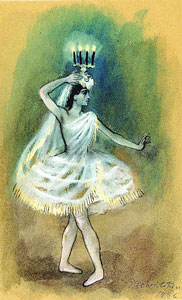Ballet Art and the ‘Bay at Nice’; bitches brew and Brooklyn scrubbed, Bermuda shorts
Among my recent travels was a visit to Connecticut’s capital city, Hartford, for a cultural double bill. At the Wadsworth Atheneum, I caught a dazzling exhibit, “Ballets Russes to Balanchine.” Largely culled from the museum’s Serge Lifar collection, the show references Hartford’s strong, if little known, connection to what was once the most avant-garde of dance/performance movements. Gay museum director A. Everett “Chick” Austin, Jr., had a vision that this could be an incorporation of all of the arts and, to that end, brought choreographers George Balanchine and Frederick Ashton from Europe in 1933. Balanchine was originally going to form a company and school in Hartford. This never happened, but he and Lincoln Kirstein did return to present the public debut of their School of American Ballet. In addition, the Gertrude Stein/Virgil Thompson opera, “Four Saints in Three Acts,” choreographed by Ashton, had its 1934 premiere in the Atheneum’s new 299-seat Avery Theatre.
Displayed are sketches and costumes by such sometime stage designers as Matisse, Picasso, de Chirico, Rouault and Derain. Highlighted are the eye-shatteringly lavish, Louis XIV raiment for “Sleeping Beauty” and sketches by Leon Bakst, which again prove that he was probably the most influential costume designer of the last century. My personal favorite was a ravishing crepe paper dress and horse-like hat, designed by Pavel Tchelitchew for the Atheneum’s legendary 1936 “Paper Ball.” The last remaining souvenir of this most fascinatingly ephemeral event, curator Carol Krute said, “You can see, it’s completely cut and sewn as if it were fabric. Amazingly durable, too, you can iron out the creases. And Tchelitchew even thought to include ruffled panties, which you can see under the skirt!” (Through January 2; 860-278-2670)
Hartford Stage is presenting David Hare’s “The Bay at Nice,” an elegant chamber piece of a play, incisively directed by Michael Wilson. As Valentina, a Russian woman who studied with Matisse, and is called upon by a museum to authenticate his work, Estelle Parsons, masterfully dressed by Willa Kim, has never looked so glamorous and gives a powerful, witty performance, sometime evoking Edith Evans. Angelica Torn plays her estranged daughter with a mixture of forthrightness and grace reminiscent of her parents, Rip Torn and Geraldine Page (her face is reminiscent of both of them, as well). Peter Maloney is touching as her unlikely beloved, and Corey Brill makes a strong impression as the Assistant Curator. The play, which is surefire Manhattan matinee-lady stuff, dealing with high kulchur and family dysfunction and dipping heavily into the extant writings of Matisse, is receiving its American debut, and was done at the National in London, with the great Irene Worth, in 1987. (Through November 14; 860-537-5151 or hartfordstage.org)
Back in Manhattan, I suffered through “Triptych,” which I had been anticipating as a chic, trenchant study of New York ladies dealing with adultery. Unfortunately, writer Edna O’Brien seems to be recycling material with a “titillating” lesbian twist from her 1972 film, “Zee & Co.” (with Elizabeth Taylor’s greatest performance), and Ally Sheedy really sucked as the mistress, with the worst British accent ever. As the spurned wife, Margaret Colin was lovely and tried to do her best with the half-baked material, but Carrie Specksgoor as her shallowly conceived, obnoxious daughter performed obnoxiously.
“Brooklyn the Musical” would be a perfectly satisfying, diverting little show—were it being presented by some high school or community theater. Unfortunately, it’s on Broadway, commanding top dollar, and its twee, flimsy script, generic music and lyrics and scrubbed-clean presentation of urban street life resolutely fail to come up to the (admittedly lowered) mark. Its 90-minute running length feels endless, not helped by the presence of an onstage clock ticking real time and each scene change being indicated with graffiti spray paint to add to the longeurs. (Isn’t graffiti a bit passé, anyway?)
The plus side is largely represented by Eden Espinosa’s uncannily huge voice, which shakes the rafters with bland power anthems. The entire cast seems to have been coached by Patti Labelle at her most overwrought, and you can’t help feeling that it’s all rather “Star Search”/”American Idol” ilk—those hysterical melismas, the eerily hollow anguish, the ever-predictable tinkle of poignancy. Cleavant Derricks nearly veers into racial caricature, Ramona Keller basically does Butterfly McQueen with street attitude and Kevin Anderson really embarrasses himself, trying to sing with a soulfulness that eternally eludes him. The costumes are, indeed clever but, after a while, too much. You will probably see the same, for free, at the Halloween parade.
And to bring you completely up to date, I have just returned from doing the unthinkable—a non-gay cruise to Bermuda. Although duly warned by everyone about the general boredom and obesity of such jaunts, the price was too good, the needs for escape too pressing, so I jumped.
One thing to be said about cruises, you can’t beat the ease of departure: a mere cab ride up to the dock at 12th Avenue where the good ship Zenith (Celebrity Cruise) awaited.
Once aboard, it became obvious that eating would be the major pastime. Formal seating, round-the-clock buffets and a nightly sushi bar could make a hog of anyone not particularly enamored of gambling, bingo or karaoke. And hogs there were, in abundance, making me sadly realize the full import of the expression “Ugly American.” Just when I’d espied someone I couldn’t imagine being any fatter, along would lope an even more gravity-challenged specimen, scarfing an éclair.
The entertainment actually wasn’t bad. Of three musical spectacles, “Broadway,” “Around the World” and “Those Fabulous Sixties,” I greatly preferred the last, as the music seemed the most happily germane to the very young, enthusiastic cast of dues-paying gypsies.
Elliot Finkel, son of great character actor Fyvush, was also on board with his piano, and regaled me one night with tales of a wacky “Anything Goes” he once directed with Ginger Rogers and Sid Caesar. Rogers refused to sing “Let’s Misbehave” (“I don’t do pornography.”) and called “All Through the Night” “garbage.” (“In the Still of the Night” was substituted.) Caesar, as Moonface, refused to sing “Be Like the Bluebird,” looked at the script and said, “I’m not saying this crap,” and had his own comedy material inserted (with the stipulation that an unthrilled Rogers be cued whenever it was her turn to resume the official show). Finkel was kept busy running with entreaties to the Cole Porter Foundation, but it was a success and marked a definite comeback for Caesar.
I was one of maybe six discernible gays on board. Being at sea, with the moonlight, a stateroom and soft breezes does tend to awake romantic impulses along the lines of, say “Now Voyager,” “Dodsworth,” “Love Affair” and “Titanic” (first reel only), but the dearth of appropriate outlets became increasingly marked as the week passed. Should desperate measures include playing footsies in the Jacuzzi with that newlywed husband with the devastating blue eyes trained on you during that conversation about his trucking business in Connecticut? And what about that too-precocious 17-year-old with the rending story about his disastrous coming-out to his upstate family (“My mom calls me faggot now.”)?
Oh well, there was more than enough drama of other types to be had, like when the glass spa shower door completely detached, banging bloodily into my forehead. The staff solicitously offered tissues, but any further inquiry into my physical well being after that was decidedly not forthcoming. This, however, was mere piffle when compared with that elderly couple who had $1,000 stolen out of their stateroom safe. They complained to Captain Michail Margaritis, who, they said, dismissed them with, “In my 30 years at sea, nothing like this has ever happened.” Sailors, beware!
As for Bermuda? Beautiful but boring, and dear God, they actually do wear those infernal shorts! It’s not the shorts, actually, that are so weird, but that knee-high black nylon hosiery that goes with it, begging the question—do they ever actually keep those on during sex?
Contact David Noh at Inthenoh@aol.com.
Designs by the Russian Pavel Tchelitchew for “Serenata” (1936) are among the visual treats on display at Hartford’s Wadsworth Atheneum through January 2.
We also publish:




































